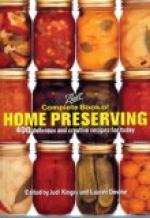The cellar which is partitioned off into small rooms is more easily cared for and kept in order than that which consists of just the one large space. Rough pine-board partitions cost very little, and one to shut off the furnace (provided there be one) from the rest of the room is absolutely necessary, since the heat which it generates must not be allowed to spread and so spoil the cellar for cold-storage purposes, for warm, damp air hastens the degeneration of vegetables and meats. Unless some other provision is made in the cellar plan for the coal, a strong bin, with one section movable, should be built for it in the furnace room. To the posts of this bin hang the shovels—one large and one small—used in handling the coal. The premature burial of many a shovel might have been prevented had its owner only bethought him of those simple expedients, hammer and nails. A strip of leather nailed to another post supports ax or hatchet, while near by is the neat pile of kindling which its sharp edge has made—perhaps out of old and useless boxes and barrels. These must not be allowed to accumulate, but be chopped up at once. Logs and large sticks have each their own pile, while chips, sawdust, and shavings take up their abode in a large basket or box. The ashes from the furnace go into boxes and barrels outside of the house.
ORDER IN THE CELLAR
The cellar is primarily a storing place for food, and not an asylum for hopelessly maimed and decrepit furniture. If there is any which is mendable, mend and use it; if not, consign it to the kindling pile at once, there to round out its career of usefulness. Odds and ends of rubbish collect very quickly and make a cellar unsightly and difficult to keep in order. If necessary to keep certain boxes for future packing purposes, pile them neatly against the wall where they will be out of the way, or else send them up to the attic. When there are no rooms partitioned off for their accommodation provide bins, or their cheaper substitutes, barrels or boxes, for vegetables and fruits—boxes preferably, since they are more shallow and their contents can thus be spread out more. Vegetables and fruits should be looked over frequently, and anything showing signs of decay removed. Instead of placing boxes and barrels, vinegar kegs, firkins, stone jars, etc., directly on the floor, stand them on bricks, small stones, or pieces of board. When so placed, they are more easily handled and moved in cleaning, and the circulation of air beneath prevents dampness and consequent decay.




